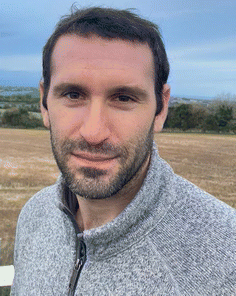Materials Horizons Emerging Investigator Series: Professor Kevin Golovin, University of Toronto, Canada
Kevin Golovin is an Assistant Professor in the Department of Mechanical & Industrial Engineering at the University of Toronto. Golovin holds a Bachelor’s from Cornell University and a PhD from the University of Michigan, both in the field of Materials Science & Engineering. Professor Golovin is the principal investigator of the Durable Repellent Advanced Engineering Materials (DREAM) Laboratory, and together with the affectionately named DREAM Team he investigates coatings, surface modification, the mechanics of interfaces, and sustainable methods for achieving solid and liquid repellency. His current research interests include ice-phobic and ice-shedding coatings, the prevention of microplastic release, sustainable replacements for perfluorinated chemistries, and smart materials and surfaces. Prof. Golovin is an inventor on 11 patents, two of which are actively licensed. He has also received various accolades, including the Eco Innovation Case Competition Grand Prize from outdoor apparel company Patagonia, and was named an Emerging Leader in Chemical Engineering by the Canadian Society of Chemistry in 2020. In 2023, Professor Golovin received the SGS Early Career Supervision Award from the School of Graduate Studies at the University of Toronto.
Read Kevin Golovin’s Emerging Investigator Series article ‘Surface-engineered double-layered fabrics for continuous, passive fluid transport’ ( https://doi.org/10.1039/D3MH00634D ) and read more about him in the interview below:
MH: Your recent Materials Horizons Communication on ‘Surface-engineered double-layered fabrics for continuous, passive fluid transport’ demonstrates improved textile design to enhance the removal of fluids such as rain or sweat, with a focus on maintaining the thermophysiological comfort of the material. How has the direction of your research evolved from your first article to this most recent article and where do you see your own research going in future?
KG: My lab has expanded substantially, both in personnel and scope, since our first article back in 2019. We started our work only looking at flat, smooth surfaces like glass or metals, and developing coatings to prevent fouling on these materials. Flash forward to the present, and we’re working on textiles, highly textured surfaces, and even catalysts. I see my lab continuing to branch out in terms of the types of surfaces we try to modify, and the properties we are trying to improve. Whereas we started with anti-fouling and low-adhesion coatings, now we’re improving catalytic stability and selectivity, fabricating smart surfaces that respond to the environment, and considering the full life cycle of the materials we choose to coat with.
MH: What aspect of your work are you most excited about at the moment?
KG: You may have heard about the “forever” chemicals that the world is considering phasing out of usage over the next few years. These perfluoroalkylated substances (PFAS) are commonplace in our field and exhibit some of the best anti-fouling and liquid-repellent properties. Right now, my lab is pioneering a replacement technology for PFAS, which is what gets me up in the morning every day. If we can replace the toxic status quo with our green, sustainable alternative, that would be a huge win for humanity and the environment and planet Earth as a whole.
MH: In your opinion, what are the most important questions to be asked/answered in your field of research?
KG: Is perfluorination best? It’s a simple question. The reason everyone uses PFAS today is straightforward: they have always shown the best performance in terms of hydrophobicity and nonstick properties. So I think a huge fundamental question worth answering is whether something better is even possible. This also means going back and reformulating our metrics for what a top-performing “repellent” coating looks like. PFAS-containing coatings always utilized a property known as the ‘contact angle’ to demonstrate their superior performance. Recent research is now pointing towards different properties being more critical for most “repellent” applications. So not only do we as a community need to ask ourselves if we can “beat the PFAS”, we also need to question what a better-performing material would look like.
MH: What do you find most challenging about your research?
KG: That there’s only 24 hours in a day. I’ve got so many questions and ideas and I can only devote so much time to each student working on the ones we’re currently tackling. Because our field is transitioning away from an entire class of chemicals that were a mainstay for decades (PFAS), there are so many new variables and unknowns and concepts that few people were thinking about even five years ago. So it’s challenging both to tackle all of these and also to know which things to focus on and explore in the most depth.
MH: In which upcoming conferences or events may our readers meet you?
KG: I will be speaking at the 2024 E-MRS Spring meeting next year in Strasbourg, France, as well as the International Workshop on Atmospheric Icing of Structures (IWAIS) 2024 in Narvik, Norway. I am always happy to speak with students and interested persons via video though, so don’t be shy!
MH: How do you spend your spare time?
KG: I am an avid soccer player and I enjoy riding my fixed-gear bicycle daily. I also love to cook and spend time with my lovely partner, Alice.
MH: Can you share one piece of career-related advice or wisdom with other early career scientists?
KG: Papers come and go but your reputation as a researcher will follow you for your entire career. Don’t get caught up in impact factors or citation indices; move with integrity, honesty, and humility and success will find you.
| This journal is © The Royal Society of Chemistry 2023 |

